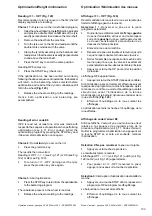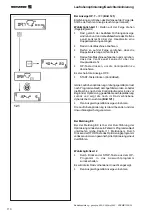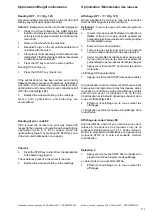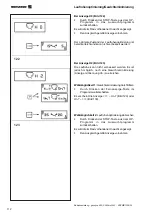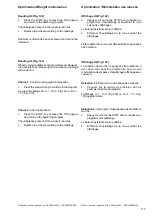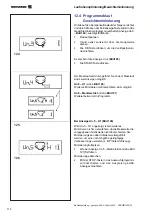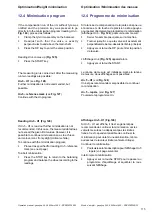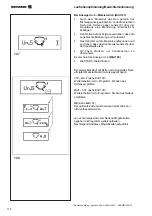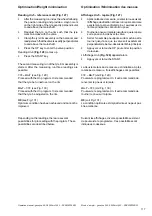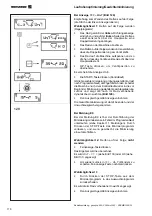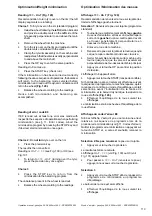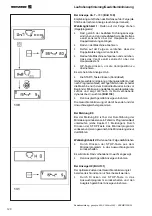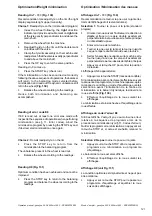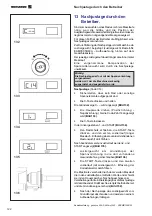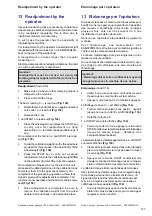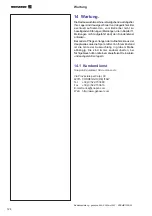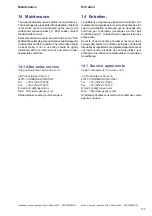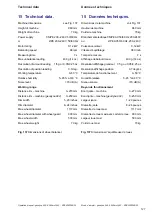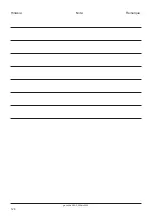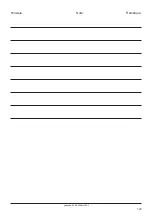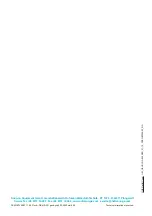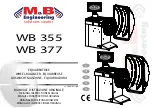
123
Mode d’emploi - geodyna 990-2,990mot,992 - ZEEWB724B03
Etalonnage par l’opérateur
Operation manual - geodyna 990-2,990mot,992 - ZEEWB724B03
Readjustment by the operator
13 Etalonnage par l’opérateur.
Si plusieurs lancées de mesure sont nécessaires pour
équilibrer une roue parce que la grandeur et la position
des masses d’équilibrage doivent être corrigées
plusieurs fois, cela est très souvent dû à une
insuffisance de précision de mesure.
Dans ce cas, l’opérateur a la possibilité de rajuster la
machine.
Pour l’étalonnage, une masse-étalon (réf.
EAM0005D40A) est fournie avec la machine (gardée à
l’arrière sur les compartiments à masses).
La lancée d’étalonnage dure plus longtemps qu’une
lancée de mesure ordinaire.
Si une compensation électrique du balourd du moyen
de serrage a été effectuée, elle sera annulée par
l’étalonnage.
Etalonnage
(Code C14)
y
Veiller à ce qu’aucune roue, ni d’autres moyens
de serrage ne soient serrés sur la machine.
y
Appuyer sur la touche C et la maintenir appuyée.
L’affichage de base C –– est affiché
(Fig. 132)
.
y
Tourner l’arbre principal (sens positif – négatif)
jusqu’à ce que le code 14 soit affiché
(Fig. 133)
.
y
Relâcher la touche C.
1. et START sont alors affichés
(Fig. 134)
.
y
Fermer le carter de roue, appuyer sur la touche
START et effectuer la première lancée d’étalonnage
(lancée de mesure longue – détection d’un
éventuel balourd résiduel).
La première lancée d’étalonnage terminée, 2. et START
sont alors affichés
(Fig. 135)
.
y
Visser alors la masse-étalon dans le trou taraudé
prévu à cet effet dans le corps de base du moyen
de serrage
(Fig. 136)
.
y
Appuyer sur la touche START et effectuer une
deuxième lancée d’étalonnage (avec la masse-
étalon – détermination des valeurs de correction).
L’unité électronique traite les données déterminées
dans les lancées d’étalonnage et les enregistre dans
la mémoire permanente. Le traitement terminé, un
signal de trois tonalités retentit et l’étalonnage est
terminé. La machine est alors opéra–tionnelle et
l’affichage de base apparaît
(Fig. 132)
.
y
Une fois l’étalonnage achevé, dévisser la masse-
étalon du corps de base du moyen de serrage et
la replacer au bon endroit.
Important:
L’étalonnage doit se faire en utilisant le moyen de
serrage fourni avec la machine de nos usines.
13 Readjustment by the
operator.
If several measuring runs are necessary to balance a
wheel because balance weight size and position have
to be readjusted repeatedly, this is often due to
insufficient measurement accuracy.
In such case the operator has the possibility of
readjusting the machine.
For readjustment by the operator a calibration weight
is supplied with the machine (ref. no. EAM0005D40A –
kept on the rear of the weight box).
A readjustment run takes longer than a regular
measuring run.
Electrical compensation of adaptor unbalance, if carried
out, will be cancelled by readjustment.
Readjustment
(Code C14)
y
Make sure no wheel or other clamping means is
clamped on the machine.
y
Press and hold the C key.
The basic reading C –– is read out
(Fig. 132)
.
y
Rotate the main shaft (positive – negative direction)
until code 14 is read out
(Fig. 133)
.
y
Release the C key.
1. and START are read out
(Fig. 134)
.
y
Close the wheel guard, and press the START key
to carry out a first readjustment run (long
measuring run – to detect residual unbalances, if
any).
On completion of the first run 2. and START are read
out
(Fig. 135)
.
y
Screw the calibration weight into the threaded bore
provided for this purpose in the basic body of the
wheel adaptor
(Fig. 136)
.
y
Press the START key to carry out a second
readjustment run with the calibration weight fitted
on the adaptor (to detect the correction values).
On completion of the second run the electronic unit
processes the data determined in the calibration runs
and enters them into the permanent memory. On
completion of the processing operation a three-tone
signal is given and readjustment is completed. The
machine is now operative and the basic readings come
back
(Fig. 132)
.
y
Once readjustment is completed, be sure to
remove the calibration weight from the wheel
adaptor and put it back in its designated place.
Important:
Readjustment must be carried out using the
clamping adaptor supplied with the machine from
our works.

